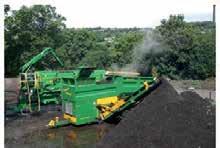
19 minute read
TIMBER TREATMENT AND
Cracking down on degrade
Timber processors have always been concerned with timber defects that relate to issues in the tree, but accelerating changes in climate, silviculture and the drive for increased growth rate, give cause for concern that certain problems may be coming more common. These kinds of defects manifest as cracks, malformed wood, discolouration and increased susceptibility to rot. They cause increased reject, and in the worse cases can interrupt the sawing process. Sometimes these defects can be seen on the logs or standing trees, but often it is not apparent at the time of harvesting, and only becomes visible when cutting. Despite the headaches this causes, there is currently little documented by Dan Ridley-Ellis NapierUniversity
information on the nature of these degrade issues, prevalence, causes and impact on timber. It is not even known whether there is more than one underlying cause.
There are three aspects to the research problem: • What are these degrade issues? • And what causes them? • Where do these degrade issues occur? • What is the impact? And how can it be mitigated?
This kind of research is best be done as a collaboration between researchers, growers, harvesters and processors. The Strategic Integrated Research in Timber (SIRT) network has started work on this and if you are willing to help with this study you can use an online form to report instances of cracks, shakes, splits, and similar defects, as and when you encounter them.
beX student Greg Campbell Andrews The study is interested in defects that occurred before the timber is dried, and that were present in the living tree (even if not visible on the standing tree or log at the time of harvest). Your descriptions and location reporting will be used to research this issue, better understand the causes, and reduce its effects in future. This survey is the first stage of research, to help plan more specific work looking at the frequency
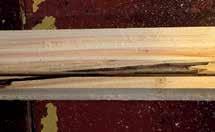
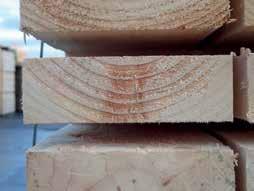

Above: two downgrade close ups (picture Dan Ridley-Ellis) Above right: Tiling batten end grain (picture Napier University Allan Shedlock)
Rate of growth and density – a ring of truth?
It is widely thought that growth ring width is a good indicator of wood density – that wider growth rings mean the wood is of low density. In many species there is, in fact, no correlation between ring width and wood density. In some, it is even the other way around. But for spruce, we do expect wider rings to mean lower density. Indeed, we have known for more than half a decade that for UK-grown Sitka spruce the latewood width is relatively constant, meaning wider rings are proportionally more of the lower density earlywood. But, this is not quite the whole picture when it comes to grading for density using ring width. When grading we are not concerned with average density, but rather the lowest density we can expect (quantified by the characteristic, lower 5th percentile, in modern standards).
of degrade events, the types, causes and consequences of the degrade, and to avoid or reduce the degrade. The SIRT network is a long running collaboration focused on understanding the physical and mechanical properties of wood and how these affect its performance in different applications. It provides support in two work packages: Work Package 1: Applied research and knowledge transfer address

ing industry needs – as set out by the SIRT management board. This includes providing information and advice to industry sponsors. Work Package 2: Timber products standards support ensuring standards are good for the domestic timber industries, and supporting industry in using them.
https://blogs.napier.ac.uk/cwst/ downgrade/
This is because it is the lowest density pieces that give us problems for things such as connections made screws, bolts or nails.
Alexandre Monseau, a student from CESI École d’Ingénieurs in France, took a close look at this question during his recent research placement at the Centre for Wood Science and Engineering, Edinburgh Napier University. Alex made new measurements, and combined them with a large dataset from previous research. The conclusion is that, while there is indeed a correlation between ring width and density in the spruce (R2 = 0.2), this is not actually very useful for strength grading. The fi rst reason is that rejecting pieces with large rings does not work very well to remove the lowest density pieces. This means the uplift in characteristic density is modest, even with high reject rates. The second reason is that, for strength grading of home-grown spruce, the density is the least critical of the properties. Even before grading, the characteristic density is more than enough to meet the strength class requirement that the timber is limited to by its stiffness.
The work done by student projects is extremely useful, often bringing new perspectives and areas of expertise from students on a diverse range of courses. Industry can take this opportunity, too – most easily through the award winning Built Environment Exchange (beX) platform led by Robert Hairstans at Edinburgh Napier University.
RESOURCES
Alex also looked at other species, and you can read his report here: https:// blogs.napier.ac.uk/cwst/rings/ For a closer look at expected relationship between ring width and density see: https://blogs.napier.ac.uk/cwst/growth-rate-and-wood-density/ And for a discussion of why ring width is, anyway, not really linked to growth rate see: http://blogs.napier.ac.uk/cwst/speed-of-growth/
First UK-grown
With the support of a grant from Forestry England’s Innovation Fund, Immanent Associates has undertaken a feasibility study exploring the viability of using UK grown hardwood timber in the manufacture of Cross Laminated Timber Panels.
To take the project forward Immanent Associates drew together a team consisting of Grown in Britain (GIB), Edinburgh Napier University’s Centre for Woods Science & Technology (ENU), the Construction Scotland Innovation Centre (CSIC) and East Brothers Timber (EBT). The study aim was to explore the potential to utilise UK grown hardwood timber in the manufacture of Cross Laminated Timber panels.
As a Feasibility Study, the scope of the project was limited to testing beech. Beech is the one UK timber that is not fully utilised. Note 1: FC Timber Utilisation Statistics 2015
Work was divided into six packages: Package 1: Desktop study of hardwood cross laminated timber production. Package 2: Delivery of fi rst beech shipment to CSIC Package 3: Gluing trials, to determine procedure and adhesive, edge bonding. Package 4: Delivery of second shipment of beech Package 5: Production of full-scale beech CLT panels Package 6: Testing for adhesive bonding, rolling shear and fl atwise bending. Package 7: Progress reports, fi nal evaluation and dissemination. Forestry England’s Innovation Fund, FORESTRY INNOVATION FUND PROJECT UPDATE hardwood CLT trials
Constraints • Processing beech requires historic and half forgotten skills • UK beech is a very variable timber • Careful selection prior to felling and processing is required. • Beech CLT an expensive product.
Advantages • It is a very attractive product • It has higher levels of stiffness than softwoods, capacity of rolling shear and negligible fl atwise bending.
After almost two years of work we have concluded that beech can be processed for CLT. The early results show that it is a viable, but expensive, new product. However, further research would be required before it could be guaranteed as compliant against British Standards and Building Regulations.
Signifi cant cost reduction would be needed to make the product an economically viable, mass-market product.
Modern technology for future wood products Laser incision
Morwenna Spear The BioComposites Centre, Bangor University

Laser cut wood is everywhere at this time of year. Wandering through my local food festival I spied plenty of examples of laser cut plywood decorations and trinkets. You’ll have seen the same if you’ve been to your local Christmas market or garden centre. It seems that everyone knows how easy it is to laser wood into pretty shapes and intricate designs.
A recent project has put the precision of laser technology to innovative use in incising wood for chemical or preservative treatments. Here the challenges were slightly different – not cutting the nice thin, flat, plywood, but making incisions part way into rough sawn timber planks, with all the twist, bow or cupping that might be expected. The project team developed a system which could accommodate the irregulari
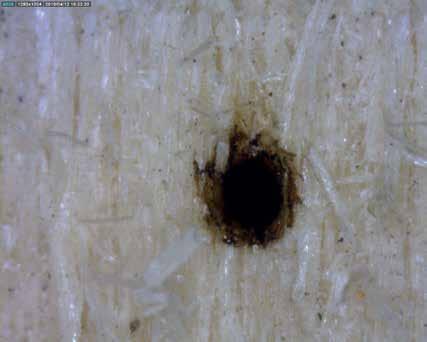
ties of sawn timber, focus the beam at an optimal distance into the plank and cleanly create minute holes in the surface.
The hole size is important. Many of you will already have seen the resurgence of mechanical incising. This is also an excellent technology, and has boosted preservative retention in difficult to treat species such as spruce. It is typically used on green timber or timber still near fibre saturation point (the point where the wood cells are empty but the wood cell wall is still wet). It has greatly assisted preservative uptake for fencing and landscaping timbers. Here the depth of incision can be a centimetre or two, depending on the geometry of the pins or knives used. It gives a relatively thick envelope of treatment, but may leave some of the core of the post untreated. In fencing applications a moderate sized incision is perfectly acceptable, and the regular slit pattern in fence posts and strainers has become a mark of quality in the market.
There are other applications where slot-shaped incisions, or the splitting which sometimes accompanies them, are not acceptable. One is window joinery – a smooth planed finish is highly desirable for solid wood joinery in this market. One joinery manufacturer I spoke to mentioned the large quantity of timber they reject or cut out of their bought timber, due to knots and blemishes, simply to keep the customer satisfied. Another application might be decking – this market seeks uniform timbers with tight grain so that splintering is not an issue. After all, the customer wants to wander barefoot on the deck in summer without issues. An incision system with sub millimetre holes could inconspicuously improve the preservative uptake for treated softwoods in this market.
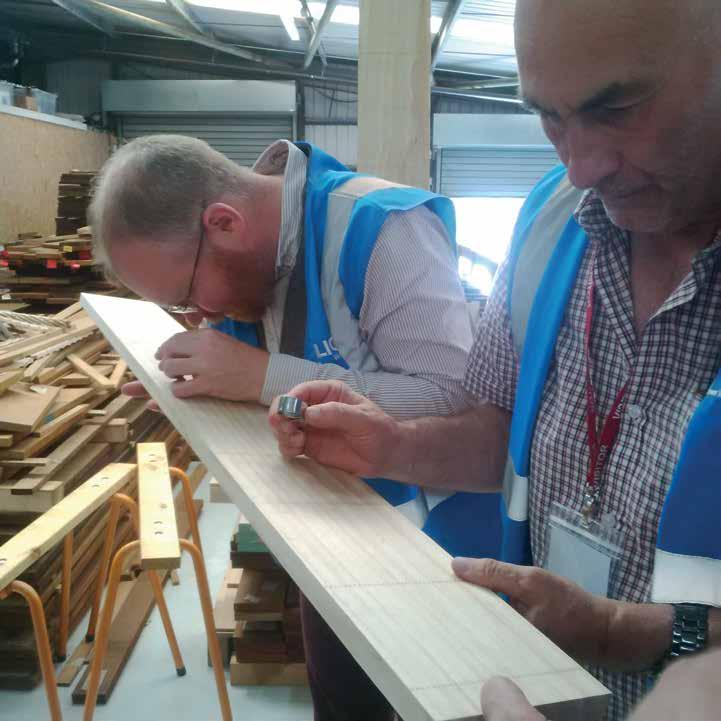
Perfectly uniform In the modified wood market mechanical incision won’t suffice either. Here the impregnation of treatment agent must be perfectly uniform (no envelope treatments allowed). Wood modification technologies such as acetylation (Accoya), furfurylation (Kebony) and resin modification (Lignia) often use Radiata pine sapwood, due to its exceptionally good permeability. This timber is sourced from New Zealand, or sometimes Chile and Spain, but cannot be grown in the UK. It would be very interesting to improve the permeability of other timbers to a level that is suited to these high performance modification systems. Laser incision is one strong contender for this. The technology allowed great freedom for those involved in the LaserCure project to experiment with hole spacings for individual Inspecting the first planks from the laser incision machine
Left: Laser hole in poplar wood
can be almost completely resistant to flow, with the tree simply relying on small quantities of sap or soluble food, hormones etc being passed from cell to cell through very small pits. Often the fibre cells are much thicker walled than the equivalent tracheid cells in softwood. Many hardwoods have prominent rays, visible to the eye in beech, oak, elm. But these rays are very poor for fluid conduction. In hardwoods the LaserCure project team spent time considering wood anatomy and which flow paths were open in each timber, to fine tune the spacing of holes to ensure greatest uptake of fluids.
species of timber, to optimise fluid uptake and distribution along naturally occurring flow paths within the wood.
Take the softwoods for example. Almost everybody will have heard the cells of wood described as being like drinking straws, aligned longitudinally in the plank, with the grain. This reflects the direction that the tree needs sap to travel while it’s growing. In some species this main route gets closed after felling, as the timber dries. The bordered pits aspirate and close the path from one cell to the next (spruce is the classic example). Some species, like pine, have stiffer fibres in the pit

membranes on latewood and don’t aspirate as easily. If a small amount of assistance can be given to these timbers to get fluid into the plank, then some flow is possible, over a reasonable distance.
Or consider the hardwoods. Few people ever consider preservative treatment of hardwood timbers, so we forget that the wood anatomy is very different to the softwoods. In broadleaved trees most flow occurs through vessels. These are formed as wide cells join end-to-end to form broad pathways over long range. Some have perforation plates of large openings between cells, so flow is very fast. The adjacent tissue
Wider variety All this may be good news to the forester. Aided by laser incision we expect to be able to treat a wider variety of timbers grown in the UK, either with traditional preservatives or with new wood modification agents. Timbers which are moderately permeable may become permeable when laser incised. Timbers of poor permeability may be upgraded to an acceptable level or treatment. Some timbers will remain out of scope however. Unfortunately, one of these is likely to be Sitka spruce, with its high degree of pit aspiration and very closed internal structure. Even with deep incisions, the preservative may access only a few millimetres from the incision. Here mechanical incision will offer just as effective an envelope treatment.
So which species can we think about? Timbers like Scots pine where latewood remains open may be greatly assisted, with long distance transport of preservative. Diffuse porous hardwoods like beech, birch, sycamore, alder. Possibly also ring porous species such as ash and sweet chestnut, depending on the proportion of libriform fibres present and their distribution. We could be looking at a new chapter for many of the timber species we currently see as minority options, or only suited to firewood. There will come a time when well managed stands of mixed broadleaf will have more available options for markets after harvest. Straightness of grain and silvicultural characteristics such as pruning and growth rate will then come to the fore. www.bc.bangor.ac.uk
Offering a comprehensive range of professional log & woodchip drying kilns for the timber industry. Log, woodchip, sawn timber, pallets & fencing.
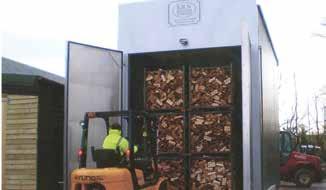
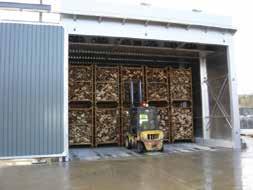
The drying programs used on our multiple air pass kilns are designed to give optimum efficiency and quality drying freshly split logs in just 5 days down to average moisture contents of 15%. A reversing air flow every 2 hours ensures uniform drying. Please note that those companies that have installed inefficient single air pass shipping containers and have existing R.H.I. contracts can now replace these keeping their existing boiler and R.H.I. contract, this gives increased production and drying quality whilst
Manufacturers of Timber Drying Kilns for over 38 years
Please visit our website for more information www.kilnservices.co.uk t: 01621 785 935 e: kilnservices@btconnect.com Kiln Services Ltd, Essex, CMO 8TE
Visit our webinar event at

https://youtu.be/G9Rluw9LtCo
REAL WORLD THINKING. REAL WORLD PERFORMANCE.
A new twist on an old classic
Hot Copper Oil alternative to traditional Creosote treatments Innovative organic co-biocide protecting against copper tolerant fungi Designed to provide an extended service life protection against decay and insect attack - 40 years for poles and sleepers Designed to protect heavy duty, high performance timbers - telecommunication and electricity poles, rail track timbers, industrial fencing

Tanasote: keeping wood as the sustainable choice
If the timber industry is to keep wood as a primary material of choice in important high-risk applications, it needs to be bold and adopt modern, innovative, Biocidal Products Regulation (BPR)- approved alternatives that will confi dently deliver both high performance and sustainability.
Tanasote is an alternative to traditional creosote treatments that will meet these criteria. Tanasote is a preservative system from the development team at Lonza Wood Protection, designed to meet the future needs of the highperformance timber sectors with attributes that will suit the agricultural, utility pole and railway sleepers industries while meeting the stringent risk assessments of the BPR.
Andy Hodge, Lonza’s marketing director, said, “Tanasote is now a real alternative for our customers involved in the supply of heavy duty timbers. It has been developed as a hot copper oil technology with a powerful co-biocide to protect against a wide spectrum of aggressive copper-tolerant decay organisms. It has an excellent industry fi t because it can be used in existing or new creosote-type plants. We are looking at 40-year service lives for poles and sleepers.”
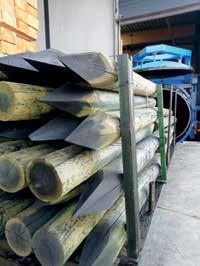
Excellent life cycle analysis (LCA) Three independent life cycle studies have been conducted with excellent resulting credentials across the board for Tanasote compared to competing materials such as steel, concrete and fi bre glass, says Andy Hodge. And all the ancillary properties such as conductivity and corrosivity of metal fi xings highlighted by the markets sectors are all similar to creosote treated timbers.
“Tanasote developments are at an advanced stage and we have gained a wide range of data from our optimising work,” said Mr Hodge. “The consistent results we are seeing are providing a great deal of confi dence that we will meet the long-term protection requirements expected. The product is currently continuing through its authorisation process within the BPR and we are extremely optimistic on the outcome. We are then looking to move forward with a commercial launch in Field testing of modern and traditional preservative treatments for communication poles. Left: Commercial trials under way for Tanasote treatments.

the early part of 2020.”
Lonza says it is ready to talk further with key stakeholders and ask that any interested parties who wish to discuss their particular requirements for Tanasote should contact them “to explore how we can work together to build these into our testing and assessment trials”.
Lonza recently held a webinar to introduce Tanasote to European markets. A recorded version is available here: https://youtu.be/G9Rluw9LtCo
Heavy Duty Professional Log Splitters
► Heavy duty splitters from 7-28 tonne capacity ► Horizontal, vertical & combi types available ► Hydraulic, PTO, engine & electric power options ► Heavy duty, robust build quality ► Incredibly fast, double pump action Heavy duty splitters from 7-28 tonne capacity Hydraulic, PTO, engine & electric power options
Heathwood Nurseries Ltd CELL GROWN TREES.CO.UK Buy the best of British
Growers of quality trees, shrubs and hedging plants. Producers of British trees and shrubs from British seed origins in cells, containers and field grown for hedges, gardens, landscaping and woodlands.
Collins Farming & Forestry Services Ltd www.collinsfarmingandforestry.co.uk



• Hedge & woodland coppicing with excavator & tree shear/grab • Ditching • Pond dredgin • Mole draining • Fendt 939 reverse drive tractor & operator hire • Arable cultivations • Wood fuel chipping to G30, G50 & CHP specs • Hedge and woodland coppicing with excavator and tree shear/grab • Poplar and large tree dismantling with high reach material handler and grapple saw • Timber extraction and purchasing • BSL registered supplier of dried and screened virgin woodchip • Wood fuel chipping to G30, G50 and CHP specs
www.heathwood.co.uk 01948 840 120 | sales@heathwood.co.uk The Meadows, Higher Heath, Whitchurch, SY13 2JA


Valley Farm, Saxmundham, Suffolk IP17 2LR 07850 988 808 / 01728 660 271 info@collinsfarmingandforestry.co.uk
` King Feeders UK (T) 01260223272 Eco Green (E ) info@kingfeeders.co.uk Composting Equipment ` King Feeders UK (T) 01260223272 Eco Green (E ) info@kingfeeders.co.uk Composting Equipment King Feeders UK ` King Feeders UK (T) 01260223272 Eco Green (E ) info@kingfeeders.co.uk Composting Equipment ` King Feeders UK (T) 01260223272 Eco Green (E ) info@kingfeeders.co.uk Composting Equipment Eco Green Composting Equipment T: 01260 223 273 E: info@kingfeeders.co.uk
WWW.ECOGREENCOMPOSTING.CO.UK www.ecogreencomposting.co.uk WWW.ECOGREENCOMPOSTING.CO.UK √ √ √ WWW.ECOGREENCOMPOSTING.CO.UK √ √ √
Why buy Eco Green? √ Range from 5 cubic metre to 30 √ Durable and robust construction √ Heavy duty 4 auger machine √ Alternative more economical 2 auger model √ Heavy duty boron blades with 2 bolt fixing √ Outlet discharge elevators built with heavy duty stainless steel chain √ Emergency stop buttons on all models as standard √ PTO / diesel / electric drives √ Rear loading hopper as standard √ Large comprehensive range of spares with next day delivery √ Nationwide in-house support team √ User safety training on all machines √ Flexible payment plans with Why buy Eco Green? √ Range from 5 cubic metre to 30 √ Durable and robust construction √ Heavy duty 4 auger machine √ Alternative more economical 2 auger model √ Heavy duty boron blades with 2 bolt fixing √ Outlet discharge elevators built with heavy duty stainless steel chain √ Emergency stop buttons on all models as standard √ PTO / diesel / electric drives √ Rear loading hopper as standard √ Large comprehensive range of spares with next day delivery √ Nationwide in-house support team √ User safety training on all machines √ Flexible payment plans with guaranteed buy back Why buy Eco Green? Range from 5 cubic metre to 30 Durable and robust construction Heavy duty 4 auger machine Alternative more economical 2 auger model Heavy duty boron blades with 2 bolt fixing Outlet discharge elevators built with heavy duty stainless steel chain Emergency stop buttons on all models as standard PTO / diesel / electric drives Rear loading hopper as standard Large comprehensive range of spares with next day delivery Nationwide in-house support team User safety training on all machines Flexible payment plans with guaranteed buy back Why buy Eco Green? Range from 5 cubic metre to 30 Durable and robust construction Heavy duty 4 auger machine Alternative more economical 2 auger model Heavy duty boron blades with 2 bolt fixing Outlet discharge elevators built with heavy duty stainless steel chain Emergency stop buttons on all models as standard PTO / diesel / electric drives Rear loading hopper as standard Large comprehensive range of spares with next day delivery Nationwide in-house support team User safety training on all machines Flexible payment plans with guaranteed buy back Why buy Eco Green? 3 Range from 5 cubic metre to 30 3 Durable and robust construction 3 Heavy duty 4 auger machine 3 Alternative more economical 2 auger model 3 Heavy duty boron blades with 2 bolt fixing 3 Outlet discharge elevators built with heavy duty stainless steel chain 3 Emergency stop buttons on all models as standard 3 PTO / diesel / electric drives 3 Rear loading hopper as standard 3 Large comprehensive range of spares with next day delivery 3 Nationwide in-house support team 3 User safety training on all machines 3 Flexible payment plans with guaranteed buy back
